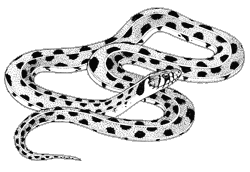Garter Snake
(Thamnophis spp.)
Order: Squamata
Family: Colubridae (colubrid snakes)
Spanish name: culebra de agua
Distinguishing Features
Garter snakes in the Sonoran Desert region are slender with a maximum length of 3¼ feet (106 cm). Most species have light-colored stripes on the top and sides of an otherwise olive-green or dark body. There are many different kinds of garter snakes, but only two will be discussed here. They are the black-necked garter snake (Thamnophis cyrtopsis) and the checkered garter snake (Thamnophis marcianus). They can be distinguished from each other by the position of the side stripe: this stripe is confined to the second and third scale rows on T. cyrtopsis and the third scale row on T. marcianus. Also the black-necked garter snake has 2 large black blotches behind the head, while the checkered garter snake has large, squarish, dark blotches in a checkered pattern on its body.
 |
Range
Both species are found throughout the Sonoran Desert. Additionally, T. cyrtopsis ranges from southeastern Utah to Guatamala and from central Texas to central and southern Arizona. Isolated populations occur in the Hualapai Mountains, Burro Creek, and Ajo mountains in western Arizona. T. marcianus is found in southwestern Kansas south to Zacatecas and northern Veracruz, Mexico, and from east-central Texas to south central Arizona and east-central Sonora, Mexico. A disjunct population occurs around the juncture of California, Arizona, northern Baja California, and Sonora, Mexico.
Habitat
Both species are semi-aquatic, generally found in or near bodies of water ranging from streams to canals, ponds, and cattle tanks. The black-necked garter snake is found from desert through mixed conifer forest, as well as tropical habitats in Mexico. The checkered garter snake usually inhabits lowland river systems, ponds, springs, streams, rivers, and irrigation ditches in arid and semiarid regions. Occasionally it is found in oak-pine woodlands.
Life History
Both species feed on aquatic or semi-aquatic prey, including fish, frogs, toads, tadpoles, worms, salamanders, and crustaceans. Lizards, small mammals, and birds may also be eaten. Garter snakes are live-bearers, generally giving birth to 6 to 18 young in the summer. If disturbed, garter snakes will bite, defecate, and emit foul-smelling musk to deter the intruder.
Comments
Garter snake habitat is disappearing throughout the Sonoran Desert due to habitat destruction and fragmentation. Garter snake numbers have also declined due to competition with and predation by introduced species such as bullfrogs and sunfish. These introduced animals eat small snakes as well as the fishes and tadpoles which are food for garter snakes.










